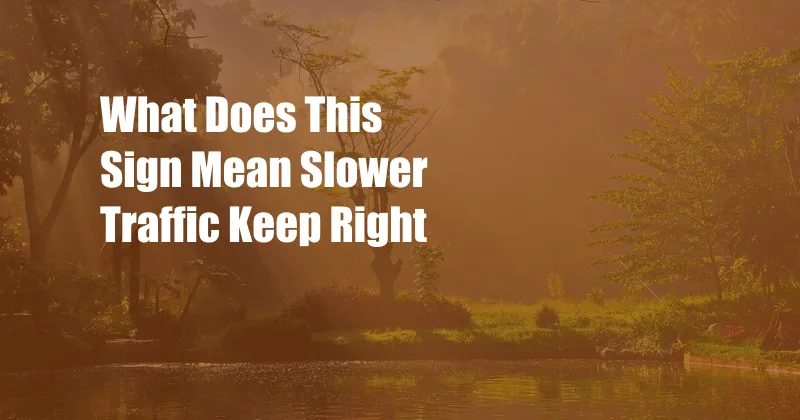
What Does the “Slower Traffic Keep Right” Sign Mean?
As you navigate the bustling streets of our cities and towns, you’ll inevitably encounter a variety of road signs designed to guide your journey. Among these signs, the “Slower Traffic Keep Right” directive holds a significant place, serving as a crucial reminder for drivers to maintain a smooth and orderly flow of traffic.
This sign typically appears on multi-lane roads where the far left lane is designated as a passing lane. It signifies that vehicles traveling at a slower pace should refrain from lingering in the passing lane and instead keep to the right-hand lanes. This practice promotes safer and more efficient driving conditions by allowing faster-moving vehicles to overtake slower ones without obstruction.
Slower Traffic Keep Right: A Deeper Dive
The “Slower Traffic Keep Right” sign serves as a beacon of common sense and courtesy on our roadways. By adhering to its guidance, drivers can avoid impeding the progress of other motorists and contribute to an overall more pleasant driving experience.
The rationale behind this sign stems from the understanding that the passing lane is intended for vehicles actively engaged in overtaking maneuvers. When slower-moving vehicles occupy the passing lane, they obstruct the flow of traffic and create unnecessary delays. By keeping right, slower traffic allows faster-moving vehicles to pass with ease, maintaining a steady pace and reducing the risk of rear-end collisions or other incidents.
Enhancing Traffic Flow and Safety
The “Slower Traffic Keep Right” sign plays a pivotal role in improving traffic flow and safety on our roadways. By encouraging slower vehicles to stay in the right-hand lanes, the sign promotes the following benefits:
- Smoother Traffic Flow: When slower traffic keeps right, it eliminates the obstruction caused by vehicles attempting to overtake in the same lane. This allows faster-moving vehicles to pass without hindrance, reducing congestion and delays.
- Improved Safety: By keeping right, slower traffic reduces the likelihood of rear-end collisions, as faster-moving vehicles can overtake without having to tailgate or engage in risky maneuvers.
Keeping in Line with Road Etiquette
Adhering to the “Slower Traffic Keep Right” sign is not only a matter of following traffic regulations but also a display of road etiquette. It reflects a consideration for other drivers and an understanding of the shared responsibility we have to maintain a safe and efficient flow of traffic.
By keeping right, slower drivers demonstrate their respect for faster-moving motorists and contribute to a more harmonious driving environment. After all, the road is a shared space, and we all have a role to play in making it a safe and pleasant experience for everyone.
Tips for Adhering to the “Slower Traffic Keep Right” Sign
Incorporating the “Slower Traffic Keep Right” principle into your driving habits can significantly enhance your driving experience and contribute to overall traffic safety. Here are some tips to help you comply with this directive:
- Be Aware of Your Speed: Regularly check your speedometer and be mindful of the speed limit. If you find yourself consistently driving slower than the prevailing traffic flow, move to the right-hand lane.
- Avoid Lingering in the Passing Lane: If you’re not actively overtaking another vehicle, resist the temptation to stay in the passing lane. Allow faster-moving traffic to pass and move back to the right as soon as possible.
- Use Turn Signals: Before changing lanes, always use your turn signals to indicate your intentions and alert other drivers. This helps maintain predictable traffic patterns and reduces the risk of misunderstandings.
Expert Advice for Courteous Driving
In addition to following the “Slower Traffic Keep Right” sign, there are other valuable tips to enhance your driving experience and promote road courtesy:
- Maintain a Safe Following Distance: Leave ample space between your vehicle and the one ahead of you. This provides a buffer zone in case of sudden stops or emergencies.
- Be Patient and Tolerant: Road conditions can be unpredictable, and not all drivers will adhere to the same standards of courtesy. Stay calm and avoid aggressive driving behaviors.
- Show Appreciation: A simple gesture of gratitude, such as a wave or a nod, can go a long way in fostering a positive driving environment. It acknowledges other drivers and shows that we’re all working together to maintain a safe and pleasant flow of traffic.
Frequently Asked Questions (FAQ)
- Q: What is the purpose of the “Slower Traffic Keep Right” sign?
A: To encourage slower vehicles to stay in the right-hand lanes, allowing faster-moving vehicles to overtake without obstruction. - Q: Is it legal to drive in the passing lane even if I’m not passing?
A: In most jurisdictions, it is illegal to stay in the passing lane if you’re not actively overtaking another vehicle. - Q: What are the benefits of following the “Slower Traffic Keep Right” rule?
A: Smoother traffic flow, reduced congestion, improved safety, and enhanced driving courtesy. - Q: How can I avoid impeding the flow of traffic?
A: Be aware of your speed, avoid lingering in the passing lane, and use turn signals to communicate your intentions.
Conclusion
The “Slower Traffic Keep Right” sign is more than just a traffic regulation; it represents a collective responsibility we have as drivers to ensure the smooth and safe flow of traffic. By adhering to its guidance, we can create a more efficient and courteous driving environment for everyone.
Remember, the road is a shared space. Let’s work together to make it a safe and pleasant experience for all. Are you interested in learning more about road etiquette and traffic safety? Share your thoughts and questions in the comments below.